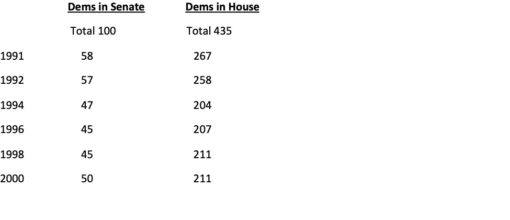Many mainstream Democrats claim if “democratic socialist” Sanders were their party’s presidential nominee, many party candidates running in down-ballot races would lose in races they should win. They warn that a Sanders’ led ticket could result in the Democrats not regaining control of the Senate and even losing their majority in the House along with many state positions.
With Biden set to secure the nomination, the message is those candidates seeing themselves most at risk should supposedly now feel more comfortable about their chances.
If history is any guide, when supposedly more acceptable and desirable “moderate” candidates have gone on to win the presidency—Clinton and Obama—in subsequent elections during both of their presidencies, the Democrats have not done very well.
When Clinton captured the White House in 1992, Democrats lost 1 seat in the Senate and 9 in the House, but they kept their large majorities. The new Congress had 57 Democrats to 43 Republicans in the Senate and 258 Democrats to 176 Republicans in the House.
With the 1994 election, the Democrats lost their majorities in both bodies. The results were 47 Democrats to 53 Republicans in the Senate and 204 Democrats to 230 Republicans in the House. However, the Democrats did not decide to abandon Clinton in 1996 despite this dismal showing. After the 1996 election, the Democrats had two fewer seats in the Senate while picking up just 3 seats in the House but remaining 11 seats short of having a majority.
The following table shows the number of seats held by the Democrats just before the election of Clinton (1991) followed by election results after each election from the year Clinton was elected to the last election held during his presidency.[1]

The Obama record is not much different. After his election in 2008, the Democrats had commanding majorities in both the Senate and the House. They picked up 7 seats in the Senate giving them 55 that soon became 58, and 21 in the House resulting in them having 256 members to 178 Republicans. Two years later, perhaps because the hope people projected on Obama resulted in disappointment, the Republicans captured the majority of seats in the House as the Democrats lost 63 seats.[2] The Democrats still held the majority in the Senate, but their number of seats declined to 51. Then, after the 2014 election, the number of Democrats in the Senate dropped to 44, making them the Senate minority party ever since.
The following table shows the number of seats held by the Democrats just before the election of Obama (2007) followed by the election results after each election from the year Obama was elected to the last election held during his presidency.

Perhaps more dismal for Democrats are the losses in the states during the time both Clinton and Obama occupied the White House. In 1990, the Democrats controlled both legislative houses in 29 states. When Clinton won the presidency in 1992, the number they controlled declined to 26 falling to 16 when he left office after the 2000 election. During Clinton’s presidency, the Republicans more than doubled their control of both house of state legislatures from 7 to 18.
When Obama was elected in 2008, the Democrats picked up control of 4 more state legislatures raising their total to 27. When he left office, the Democrats controlled just 14 while the Republicans again more than doubled their total from 14 to 32.
During Obama’s time in office, the number of Democratic governors also declined. With his election, the total number of Democratic governors increased by 6 to 28. After the 2014 election, they totaled 21 declining to only 18 after the 2016 election.[3]
These losses in the states have paved the way for effective voter suppression efforts causing much harm to the prospects of Democrats.
In the table below, the first year listed is the total before the elections of Clinton and Obama.[4] Note: Nebraska has a one-house legislature.

1972 Election: When a Real Liberal Headed the Democratic Ticket
Nixon won over 60% of the votes cast in the 1972 presidential election. George McGovern, the Democrat’s presidential candidate and, by far, the most liberal candidate the Democrats have put forward in almost 50 years, secured less than 38% of the popular vote. Nevertheless, the Democrats gained two seats in the Senate increasing their majority to 56. The number of Democratic seats in the House declined by 11, but left them with a commanding majority of 241 to 192.[5] The Democrats even elected an additional governor that year raising their total to 31. Obviously, the conditions in the country were much different.
If this record is a guide, it clearly indicates that the harm a Sanders’ candidacy would do to down-ballot candidates is at least questionable.[6] The Democrats might gain a few seats in 2020 were Biden at the top of the ticket and the election not cancelled, but if history is any guide, they will suffer big losses in subsequent elections during a Biden presidency.
Notes.
1. All of these numbers come from Wikipedia at sites including https://en.wikipedia.org/wiki/103rd_United_States_Congress One needs to enter each term of congress. These numbers change during the term. One may find slightly different numbers at other sites such as the one found at endnote 4. ↑
2. Disappointment may have come from Obama’s decision to choose officials to head his administration who were devoted to bailing out the financial industry while doing little to prevent home foreclosures or alleviating poverty, failing to put in place promised policies that would ease difficulties organizers of workplace unions face, and not fighting to increase the minimum wage. Adding to their disappointment could have been Obama’s decisions to keep Bush’s Secretary of Defense as part of his administration, to escalate the war in Afghanistan, and to not prosecute those who committed and were responsible for torturing people. ↑
3. https://www.statista.com/statistics/198486/number-of-governors-in-the-us-by-political-party-affiliation/ ↑
4. https://web.education.wisc.edu/nwhillman/index.php/2017/02/01/party-control-in-congress-and-state-legislatures/ ↑
5. https://en.wikipedia.org/wiki/93rd_United_States_Congress ↑
6. Obviously, the problems/issues around the virus are changing everything.